Riding the Rails: Transforming Chicago's CTA into a Joyful Experience
Is it possible to introduce joy into the CTA riding experience? Four UIC students set out to find out.
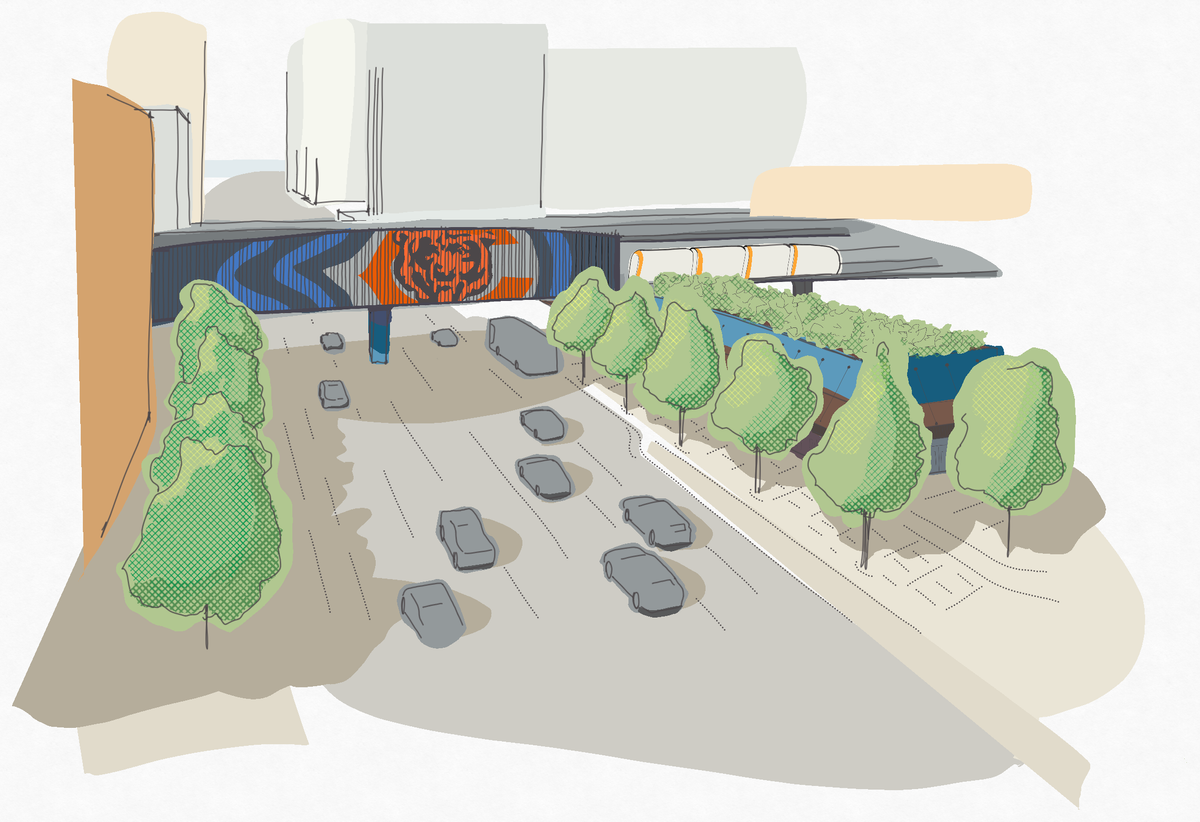
Transforming your everyday commute into a joyful adventure may seem like a lofty goal, especially when it comes to navigating the bustling metropolis of Chicago on the CTA.
Yet, that is precisely the mission driving our University of Illinois Chicago, Senior Capstone project led by students Evan Bratina, Taylor Lebron, Alexander (Xan) Gordon, and myself, Kasie Nette. We sought to infuse the CTA experience with a newfound sense of delight and satisfaction.
Overview
Let's face it – many CTA stations have room for improvement. From outdated facilities to lackluster amenities, there's a definite need for a facelift. That's where our project steps in – we sought to uncover innovative solutions that enhance the passenger experience from start to finish.
We teamed up with GoArchitect, an up-and-coming Chicago design & planning firm, to explore how 3 different CTA stations can support Chicago commerce, safety measures, and tourism while also sparking joy in passengers.
Our Process
Using Engage, we surveyed over 300 riders and community partners. From spirited in-person discussions to enlightening interviews with Block Club Chicago and WTTW, every interaction informed our proposals tailored to the unique needs and desires of CTA riders.
Focusing our lens on bustling hubs like the Loop and River North, we selected 3 stations along some of the busiest routes in the city.
- UIC Halsted
- Roosevelt
- Clark/Division
Our project unfolded in two distinct stages – first, gathering initial insights to inform our design proposals by surveying community partners, and then presenting these proposals for further refinement through this second survey. It was a dynamic process aimed at ensuring our ideas resonated with CTA customers.
Stage 1: Engage Survey Results
We studied themes such as: safety & security, seating & comfort, aesthetics, and accessibility. Each theme served as a guiding principle for our proposals. And who knows? Perhaps our vision for the future of the CTA will extend far beyond our initial scope, encompassing every station in its radiant embrace. 😄
Demographics
We selected a diverse range of demographics to ensure a comprehensive understanding of community perspectives. These demographics included age, employment status, gender identity, and race. Race and ethnicity responses were optional. We observed a fairly even distribution of survey respondents across various gender identities, which adds an intriguing dimension to our analysis.
Age of Ridership: A significant proportion of respondents fell within the 25 to 35 age bracket, closely followed by those aged 36 to 65. This demographic distribution underscores the profound influence of this age range on social and workforce trends.
Time of Day: There is a well balanced distribution across ridership time with the midday period (9am - 3pm) taking the lead, closely followed by the afternoon (3pm - 6pm).
This data suggests that a considerable segment of CTA riders are active members of the Chicago workforce who rely on the CTA for transportation to and from work. This underscores the pivotal role of public transit in daily life for many Chicagoans.
Core Themes
Safety & Security
Unsurprisingly, safety and security was a critical topic among CTA riders. During our discussions, many people expressed feelings of insecurity. Recurring issues like inadequate lighting, confusing wayfinding, and columns or other objects obstructing visibility were present at all stations. These observations informed our goal of enhancing the safety and security of passengers across all stations.
Riders were asked, “Please rate how comfortable you feel at this station (1-5, with 5 being the highest rating).” Roosevelt station had the worst average ratings closely followed by Clark/Division. UIC-Halsted had the highest average safety ratings.
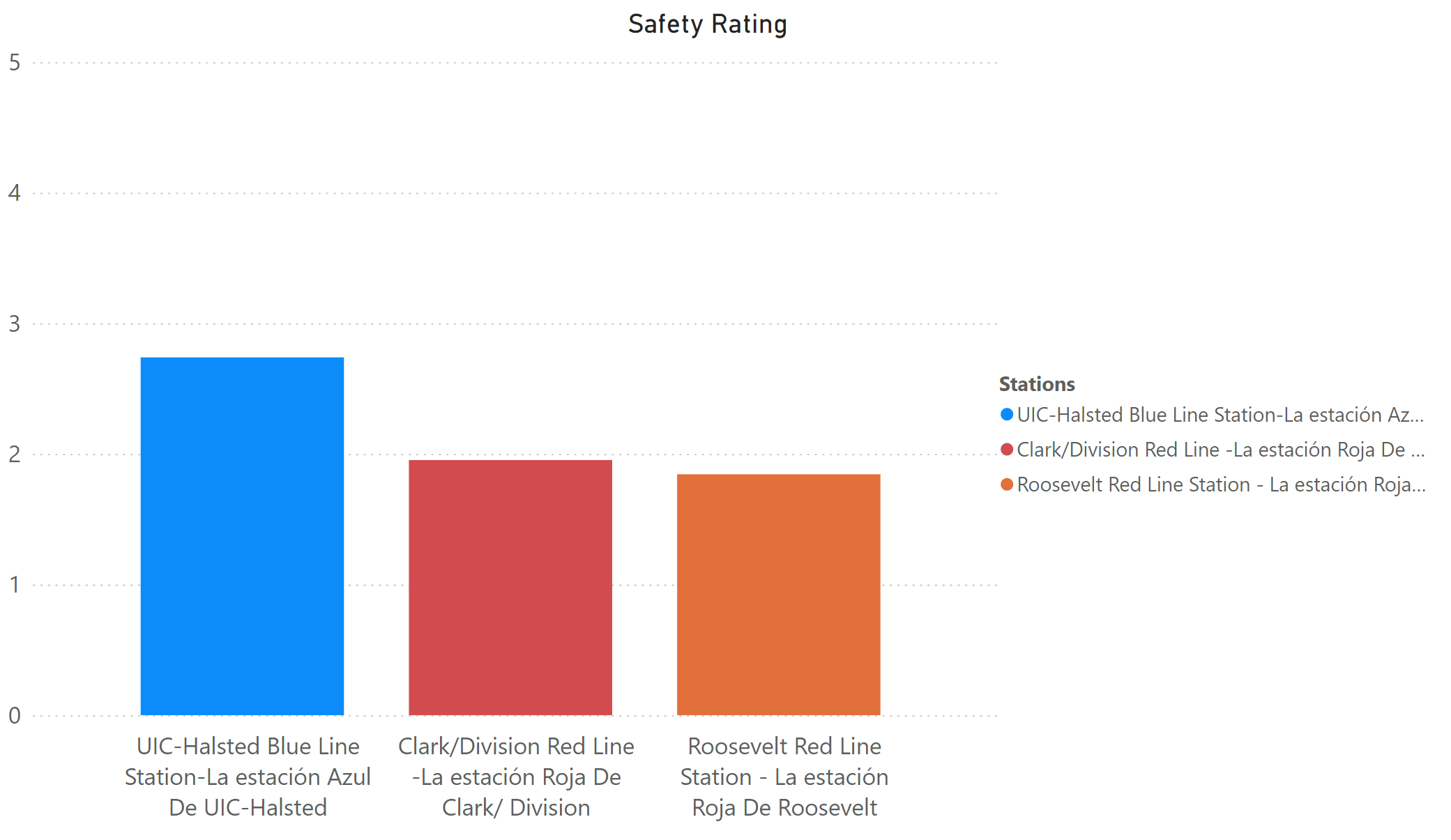
Seating & Comfort
Our research highlighted a lack of sufficient seating, which significantly impacts passenger comfort. Feedback also indicated a strong aversion to hostile-style seating, which deters individuals from utilizing available seating options.
By incorporating more generous seating, we can improve the comfort, positivity, and convenience of waiting passengers.
Rider were asked, “Please rate how comfortable you feel at this station please rate places to sit at the station (1-5, with 5 being the highest rating).
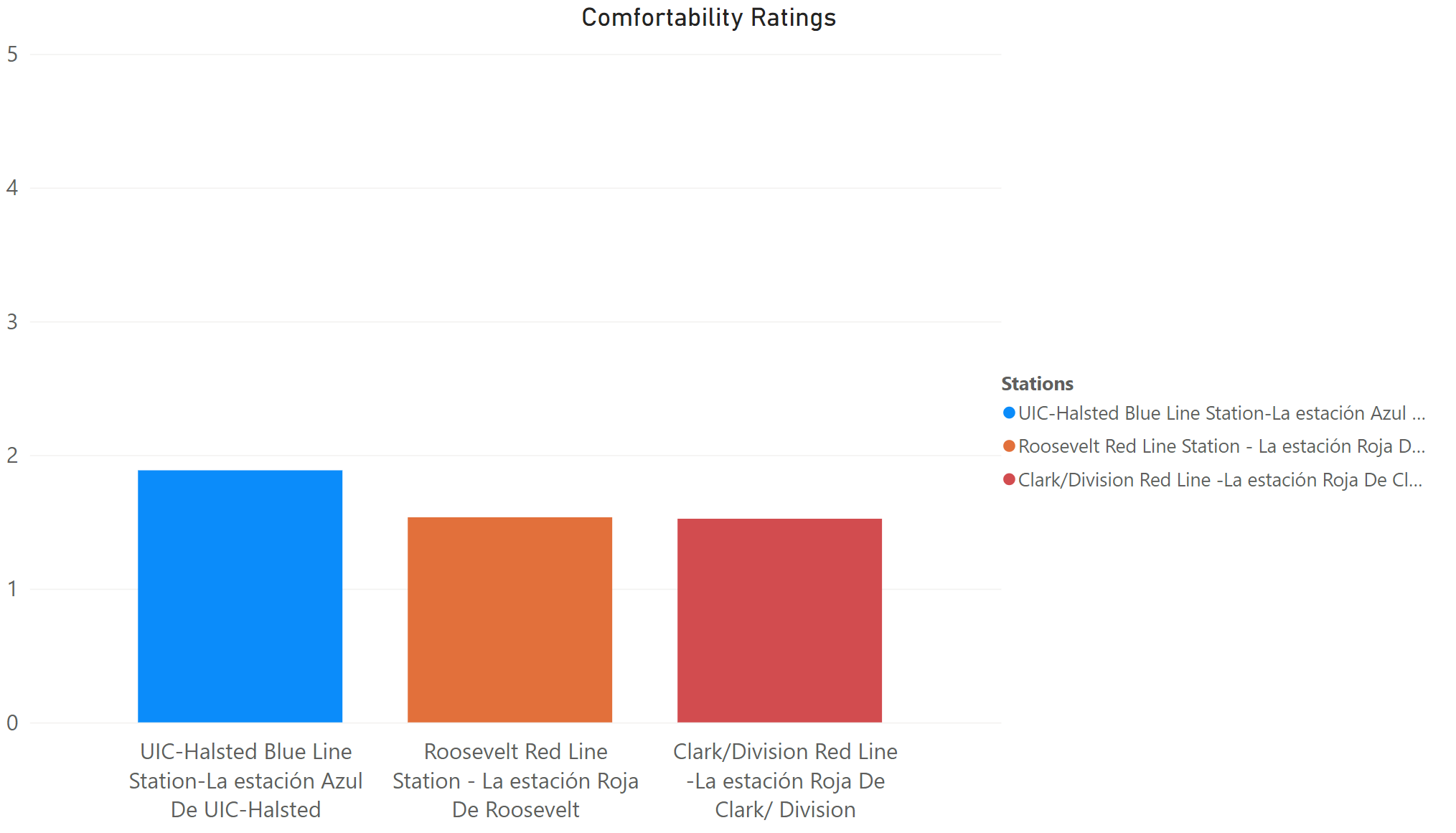
Art & Murals
Our investigation revealed a strong lack of interest in repetitive station advertisements. Instead, there was a strong preference for incorporating local art and murals, which have the potential to evoke a sense of joy and connection. There is an untapped potential for passengers to experience a reflection of the neighborhood's personality when arriving at specific stations.
Art & Murals can Boost Tourism
We propose integrating artwork and murals into each station to elevate its aesthetic appeal and cultural identity. By infusing these artistic elements, passengers can be immersed in a unique atmosphere that celebrates the pride, diversity, and creativity of Chicago.
We propose an exciting project to organize a citywide contest, inviting local artists to design murals for each of the 145+ CTA stations. The goal would be to transform every station into a welcoming and visually appealing space, while also turning them into tourist attractions.
Riders were asked, “Please rate the visual appearance of this station. (1-5, with 5 being the highest rating)”
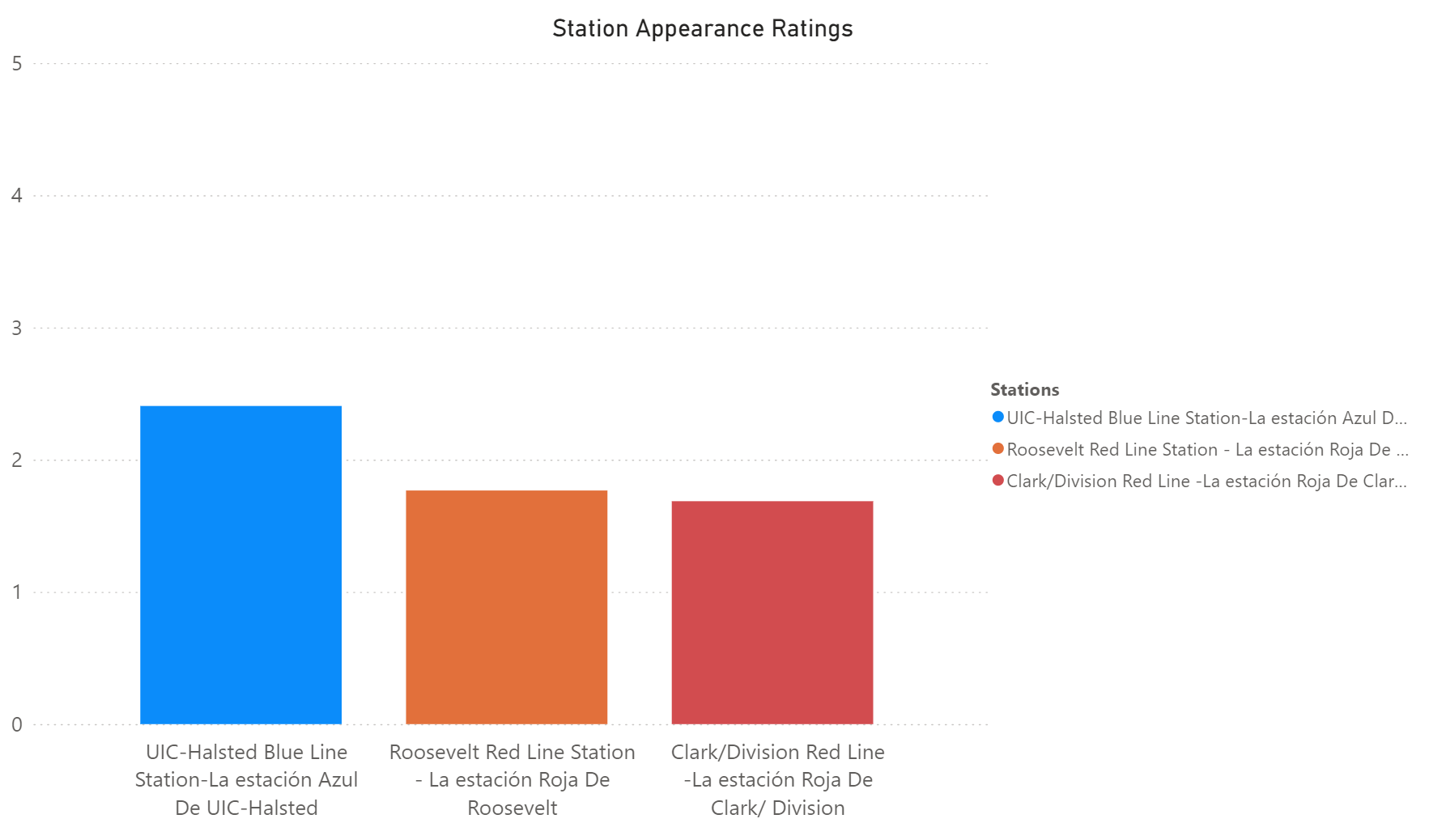
Accessibility
Our research revealed stark disparities in station accessibility. It's imperative that all passengers, including those with disabilities or mobility challenges, can navigate the transit system with ease and dignity.
To address these issues, we advocate for comprehensive measures to ensure universal accessibility across all stations. This entails not only complying with basic accessibility standards but also embracing principles of inclusive design. By incorporating features such as ramps, elevators, tactile paving, and clear signage, we can create a truly accessible environment that empowers all passengers to travel independently and comfortably.
It's essential to consider the broader context of accessibility to provide accessible information and assistance services, as well as fostering a culture of inclusivity and respect among staff and fellow passengers. By adopting a holistic approach to accessibility, we can create a transit system that is welcoming and inclusive for everyone, regardless of their abilities or limitations.
Riders were asked, “How would you rate the accessibility of this station? (1-5, with 5 being the highest rating).”
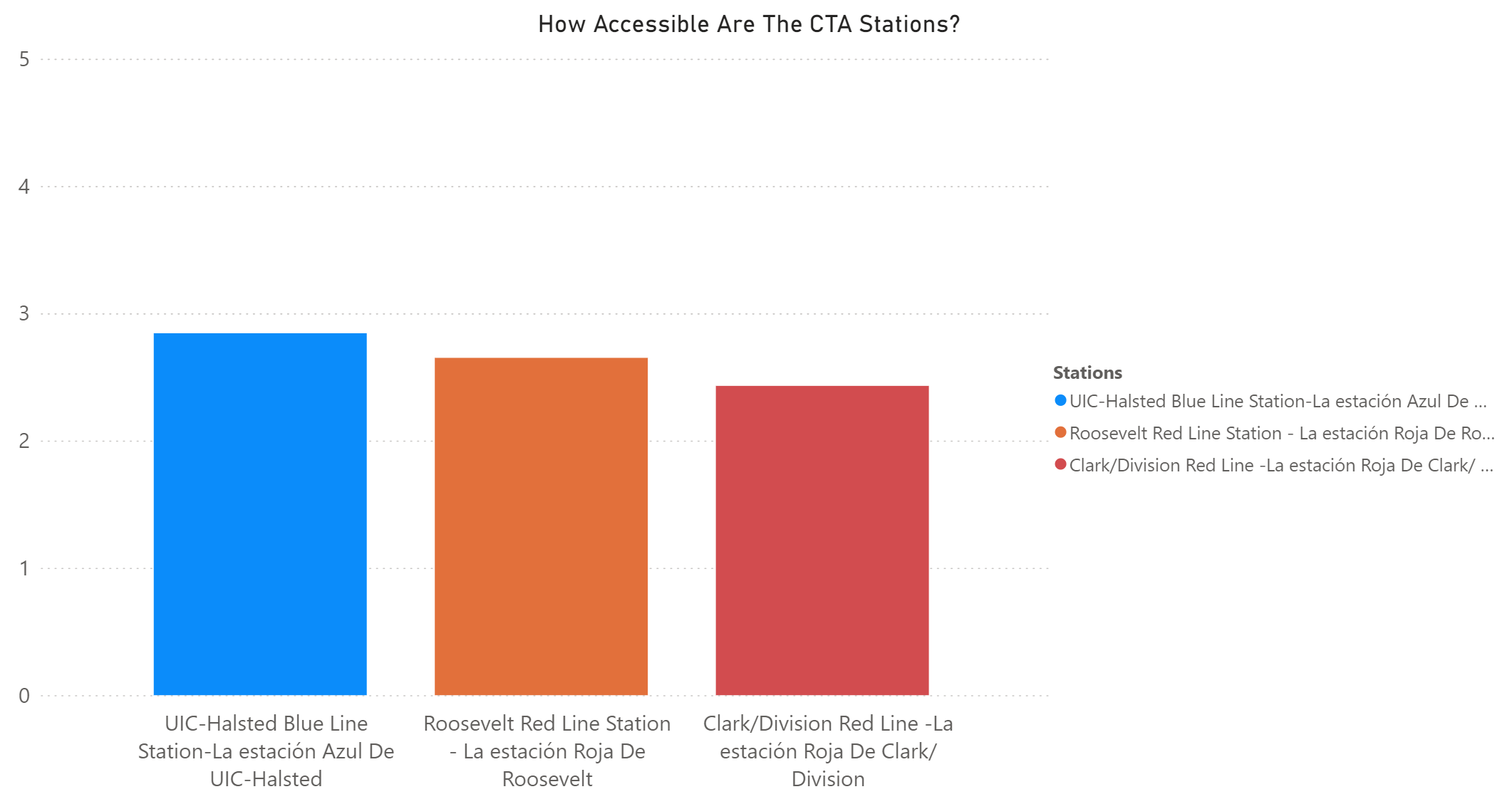
Proposals
Now, let's dive into each station individually, emphasizing the core themes and exploring how our proposed solutions align with these community input themes to drive meaningful improvements.
Station 1: UIC Halsted
The UIC Halsted CTA Station stands at the intersection of functionality, aesthetics, and future-forward design. Community feedback identified key areas for improvement to create a station that serves its immediate purpose and embodies the spirit of progress and innovation.
Key themes were: wayfinding towards 95th Street, disruptive noise pollution from nearby freeways, outdoor heating, and environmental comfort.
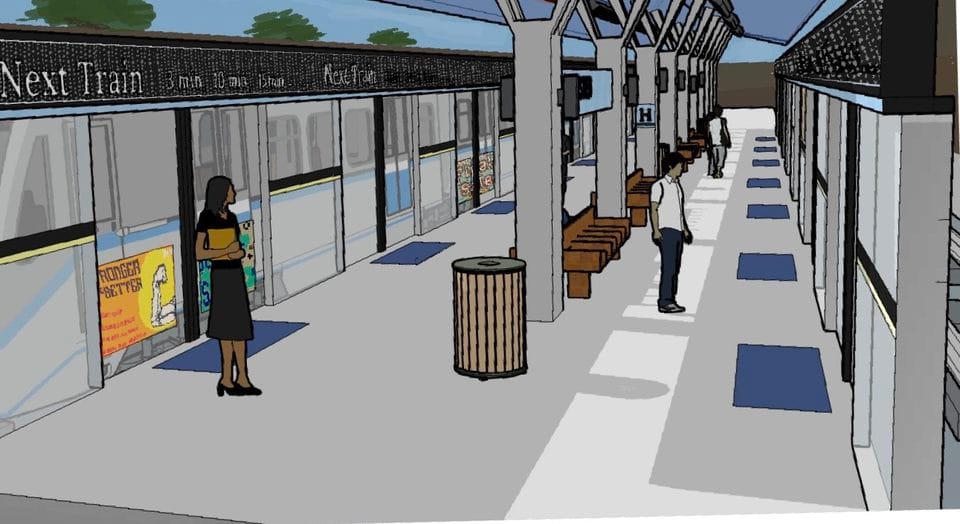
The desire for outdoor heating and effective environment control highlights the importance of creating a pleasant atmosphere for commuters, regardless of weather conditions. Through strategic wayfinding we enhance navigational clarity while optimizing surface area for informative displays, ensuring that every traveler can easily find their way.
Looking forward to the future of Chicago's stations, we incorporated glass guard rails and noise barriers to elevate safety, minimize noise, and create a three-season station to support passenger comfort.
Advertisements have been moved to these doorways to make space for seating. Additional benches are provided for seating comfort, while garbage cans are visibly cleaner, contributing to a more pleasant environment. Moreover, softer light fixtures create a less harsh ambiance, improving the overall atmosphere.
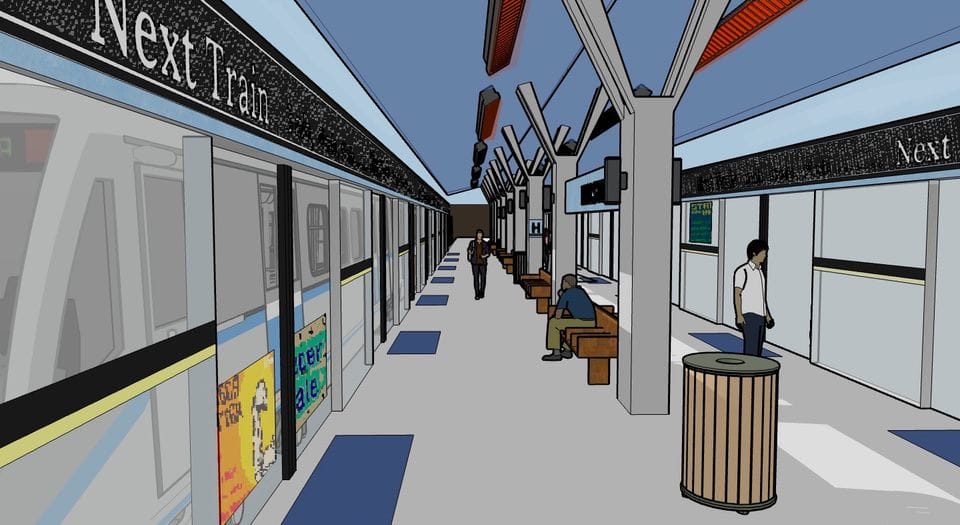
With the growing significance of West Loop and Fulton Market, the UIC Halsted Station can act a key community node, primed to support future residential and commercial growth.
The UIC Halsted CTA Station represents more than just a transit hub—it's a testament to Chicago's unwavering commitment to progress, innovation, and community. Through branding and establishing the station as a distinctive gateway to both UIC and Greektown, the station can serve local tourism, residents, and commerce.
Station 2: Roosevelt Red, Green, & Orange Line
Roosevelt is unique because it serves 3 CTA lines and includes an above and underground platform. Each presents unique challenges and opportunities for transforming the Roosevelt Station into a vibrant and accessible hub.
Community feedback for Roosevelt CTA Station revealed key areas of improvement: safety, wayfinding, accessibility, cleanliness, and creating a welcoming gateway to the city. The general sentiment was the need for a comprehensive revamp of the station.
The vision for this CTA station is one of innovation, functionality, and community engagement. We see the potential for this station to set a precedent for future developments, particularly in terms of branding and commercial opportunities. With prominent sports and cultural institutions nearby, the station serves as a gateway to the city. We envision a station that is visually striking and commercially dynamic.
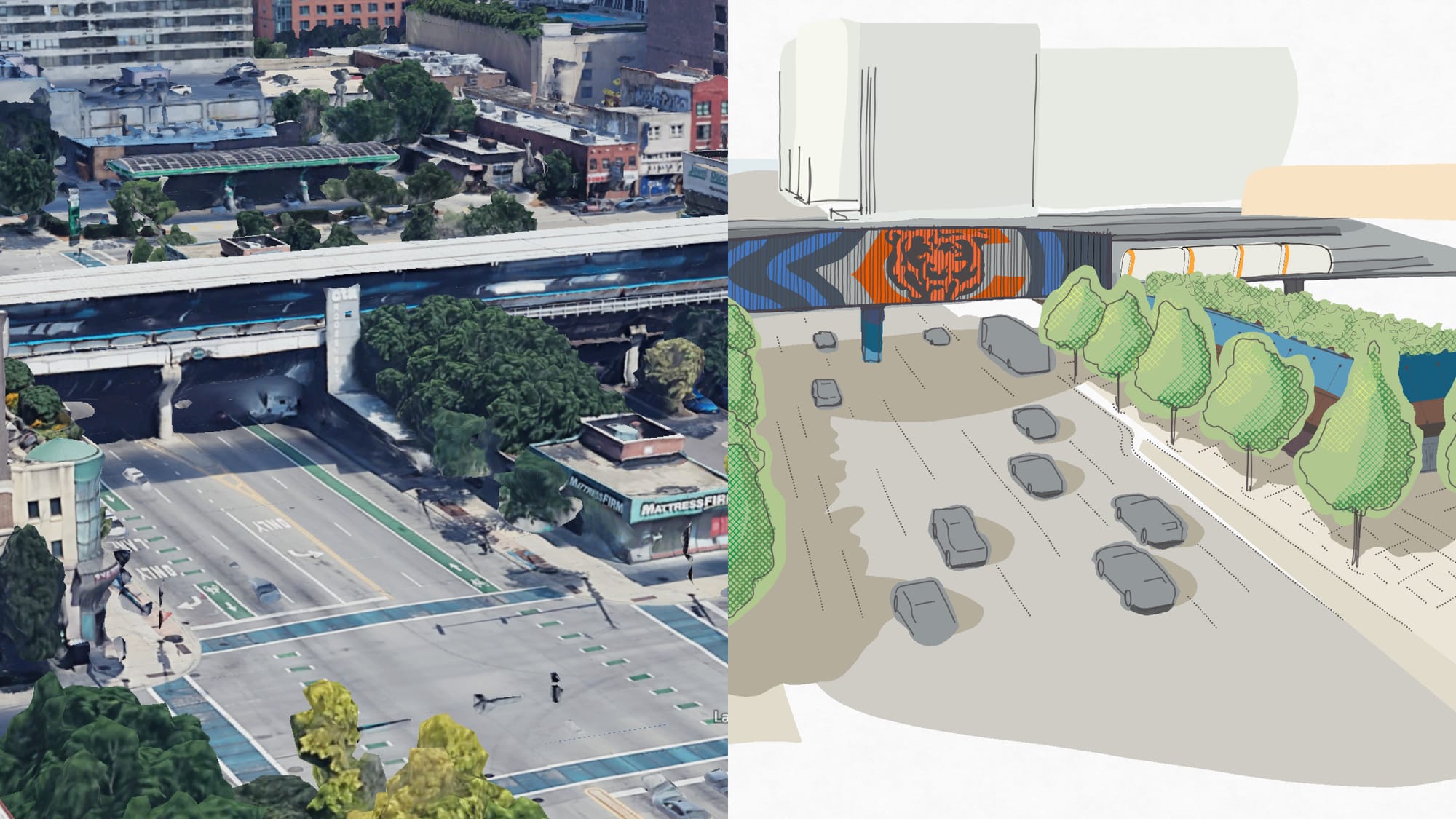
In this before and after rendering, the exterior of the Roosevelt Station bridge features a semi-transparent LED display to showcase upcoming events. CTA can earn revenue from this display and partner with local teams, museums, and developments.
The station can also expand on the southern side of Roosevelt Road, replacing the "Mattress Firm" building, to create a better & accessible entrance experience for riders going to the Green and Orange lines.
This expansion of Roosevelt Station as an entertainment hub will be paired with interior and exterior improvements like: expanding comfortable seating, improved wayfinding, more consistent maintenance & cleaning, and significant architectural changes.
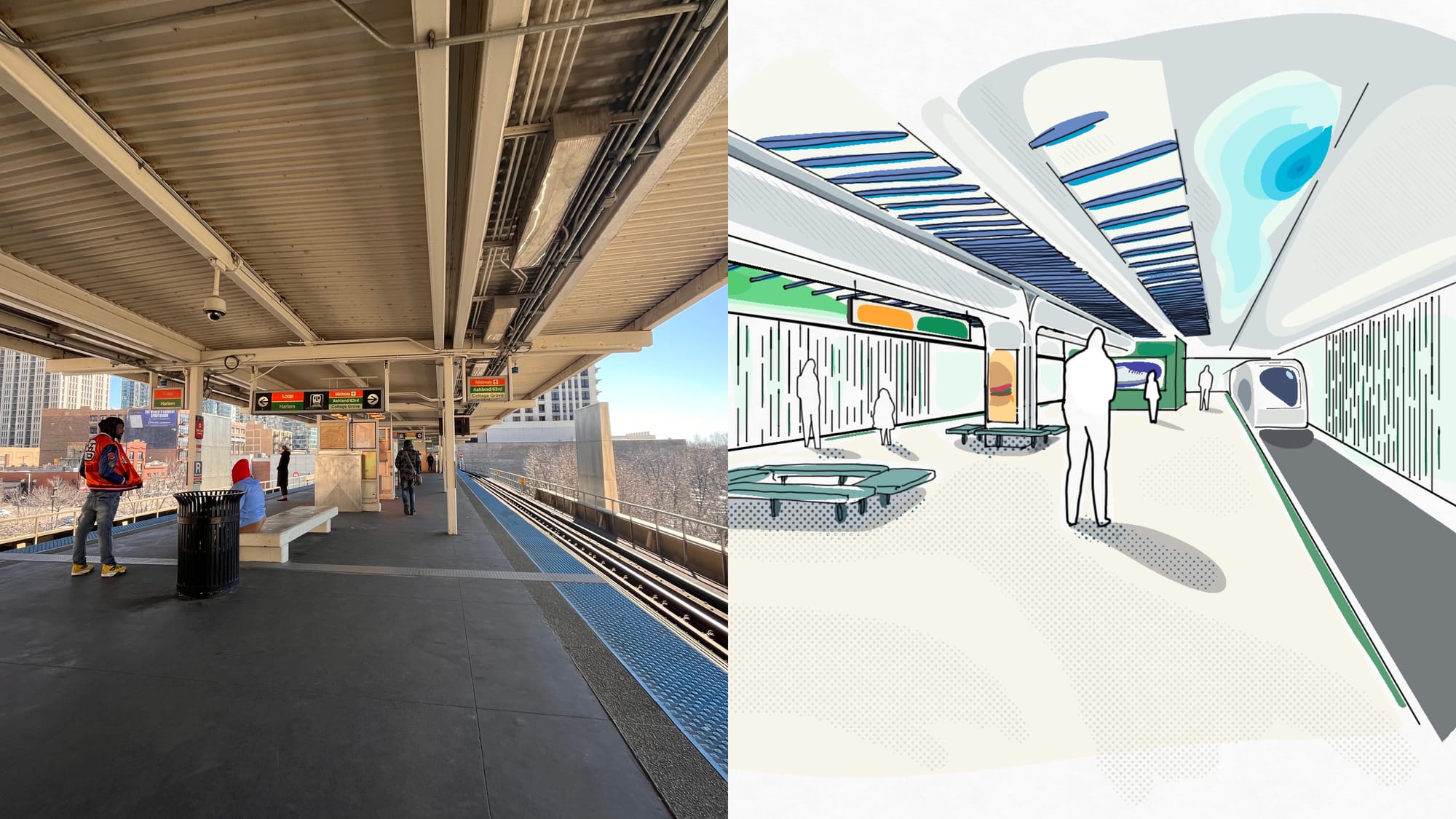
The updated design features comfortable benches, vibrant ceiling murals, and a semi-enclosed structure that protects travelers from the elements. We aim to infuse the station with more personality while improving it's efficiency.
The underground areas of Roosevelt station will also be improved. Central to our vision is the incorporation of murals as a defining aesthetic element. With mural space on the ceiling illuminated by indirect lighting, we transform the station into a dynamic and visually captivating space. These murals serve as a canvas for local artists and foster a sense of community and cultural vibrancy.
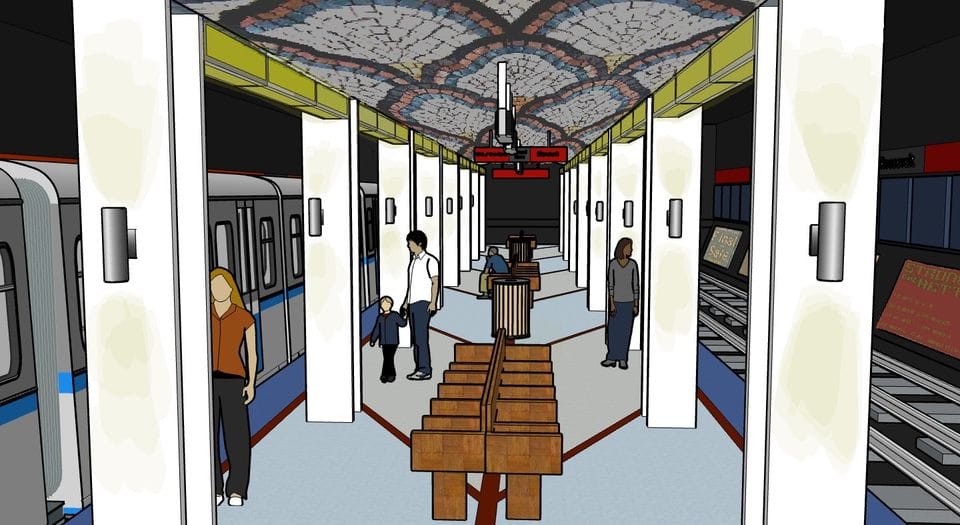
We prioritized passenger comfort and convenience. By moving advertisement panels to the outside of the rails, we can open sightlines and enhance rider comfort. We incorporated elements such as indirect lighting fixtures and ventilation systems to ensure a comfortable environment year-round.
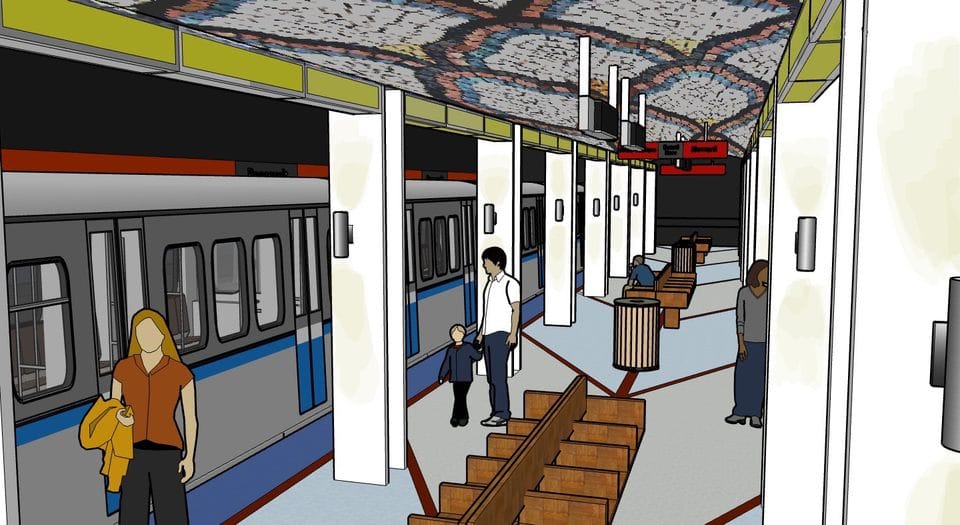
Our goal is to create an inviting, safe, and efficient station that serves as a point of pride for residents and visitors alike.
With careful planning, thoughtful design, and community input, we're confident that the Roosevelt CTA Station will become a cornerstone of the city's transit network and boon to the tourism industry.
Station 3: Clark/Division Blue Line
Feedback for the Clark/Division Blue/Red Line CTA Station revealed a compelling narrative of aspiration and enhancement. Community members emphasized the importance of creating a sense of expansiveness within the station. This focus on space & lighting can support better station branding, particularly for the Red Line, to evoke a stronger sense of identity, connection, and comfort.
The key themes are: maximizing space, improving ambiance, and adding personality to the commuter experience.
To address space constraints, we explored design strategies such as color blocking and atmospheric lighting. By incorporating inviting and indirect lighting with strategically placed seating areas, we created a sense of openness that encourages passenger comfort.
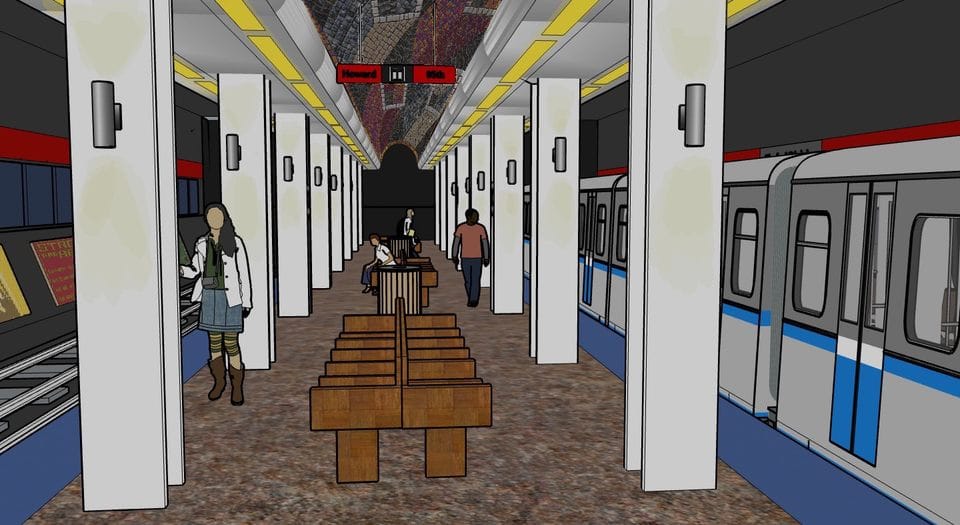
By transforming the dome into a mural through a citywide mural competition, we celebrate the unique character of this neighborhood and create opportunities for local artists to showcase their talent.
Considering both tourists and locals, we aim to position the station as a destination gateway. By highlighting nearby attractions and amenities, such as restaurants, bars, and entertainment venues, we create a sense of excitement and curiosity that draws visitors and residents alike to explore the area.
The station's aesthetic can be modernized through the strategic use of lighting and color. By incorporating elements of negative space and maintaining key design elements such as the iconic red color scheme, we honor the station's utilitarian roots while elevating its aesthetic appeal.

Our goal is to transform the Clark/Division CTA station into an inviting space that reflects the essence of this neighborhood and serves as a gateway to the areas rich cultural landscape. With bold design choices, community engagement, and a focus on enhancing the passenger experience, we're confident this is possible.
What comes next?
As we conclude this phase of the CTA study, it's clear that we're only scratching the surface of what's possible. Looking ahead, we envision a future where our proposed improvements encourage further study and help to elevate not just the functionality of stations but also the spirit of our city.
With continued dedication to community engagement, technological innovation, and community collaboration, we're confident that the CTA can become a beacon of efficiency, accessibility, and cultural vibrancy. Together, we can turn this ambitious vision into reality, creating a transportation system that not only meets today's needs but also paves the way for a brighter, more connected Chicago.
Please click here to participate in the final survey and share your thoughts.
Thank you to GoArchitect for their support during this project.
